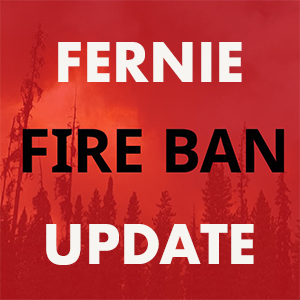The majestic beauty of the mountains is awe inspiring to almost anyone, but for a geologist, looking at mountains is like seeing an ancient warrior whose battle scars reveal millions of years of history. The Rocky Mountains of Canada offer some of the best exposures of geology in the world. Let’s take a look at three of the finer sites in the area, Mount Hosmer, the Palliser Formation, and the Coal Creek ammonite.
Mount Hosmer

The most visible geological structure in the Fernie area is Mt. Hosmer (above). It represents the vertical portion of a fold. The fold is on the leading edge of the Hosmer thrust fault, which has been traced along the Elk Valley from the tunnel to north of Mt. Hosmer. The fault places older strata on top of younger, ending up with upside down mountains! Because of this same fault/fold, strata along the Lizard Range are near vertical to overturned, with the younger rocks exposed on the lower slopes and the older strata at the top. Mount Hosmer can be viewed from anywhere in Fernie, the bedding (strata) is best seen in the evening.
Palliser Formation
Several spectacular cliffs are within an hour’s drive of Fernie, the “China Wall” on the south slope of Mt. Broadwood, the peaks of the Three Sisters, and the Soda Wall, which forms part of a ridge behind the Three Sisters. What are these massive layers and why are they so prominent?
We have to remember three important steps to understand the present day geology. Step one is the deposition of the sedimentary layers or strata, step two is the structural deformation of these layers, the mountain building, and three is the more recent erosion, from glaciers, steams and rivers, to form what we see today.
The Palliser Formation is of Late Devonian age (360 to 376 million years old) and is the result of the deposition of lime mud and skeletal material (fossil shell fragments) on a sea floor. This warm, shallow, ancient sea covered all of B.C., Alberta, southern Saskatchewan and parts of Montana. The layers of lime mud were compacted into rock with time and pressure.
With mountain building the Palliser remained a thick, massive layer that was not easily folded or broken. The China Wall is a beautifully exposed occurrence on the south face of Mt. Broadwood that is several kilometres long. The Soda Wall forms the east face of Mt. Bisaro while the peaks of the Three Sisters represent a stack of up to three layers of the Palliser that have been folded and piled onto each other by thrust faults.

Other spectacular occurrences of the Palliser Formation include the highest portion of the Lizard Range from above the tunnel to above Island Lake. The western, highest portion of Mt. Hosmer, and the lower cliffs of Crowsnest Mountain (pictured above).
To find the China Wall, take the Morrissey turnoff on Hwy. 3 and travel south on the Lodgepole Creek road to the Ram Creek junction. Then take the Ram/Wigwam road, cross Lodgepole Creek and go a few kilometres up the Wigwam road. Stop and turn around to view the great cliffs.
The Three Sisters can be viewed from anywhere in Fernie. By going past Harley Lake and travelling a few kilometres down Sulphur Creek you can get a great view of the north side of the peaks.
Coal Creek Ammonite

One of the largest fossil ammonites ever found was in the Coal Creek drainage. This poorly preserved fossil is 1.4m across and 35cm thick. Most of the ammonite is preserved as an imprint with part of the last whorl appearing as a mould.
The ammonite, which looks like a coiled squid, is an ancient relative of the nautilus, which swims around in the shallow water of the South Pacific.
While living, the ammonite would have been happy in the sub-tropical Jurassic Sea that covered the area between 200 and 145 million years ago. The sea extending from Montana north through central B.C. and from southern Saskatchewan and Manitoba west through most of B.C. The animal swam around in a vertical position and by varying the air pressure in its chambered shell was able to change depth.
After it died, the soft parts of the animal would have disappeared leaving only the shell. The shell was probably then swept onto a beach and filled with sand where it was buried and eventually fossilized.
In our area, ammonites are common in the Jurassic Fernie Formation (as are dinosaur balls), which underlies most of the valleys in the area. Numerous fine specimens have been found in the upper Fording River valley where Fording Coal built their coal handling facilities. Another giant ammonite, about 0.75m across, was found at the Coal Mountain mine. Many smaller specimens have been found throughout this area. One of my samples is from Fernie Alpine Resort.
To find Coal Creek ammonite you must walk up the second draw from Fernie on the south side of Coal Creek. It can be a difficult site to find so good luck and please leave the ammonite as you find it.
By Bob Morris

























